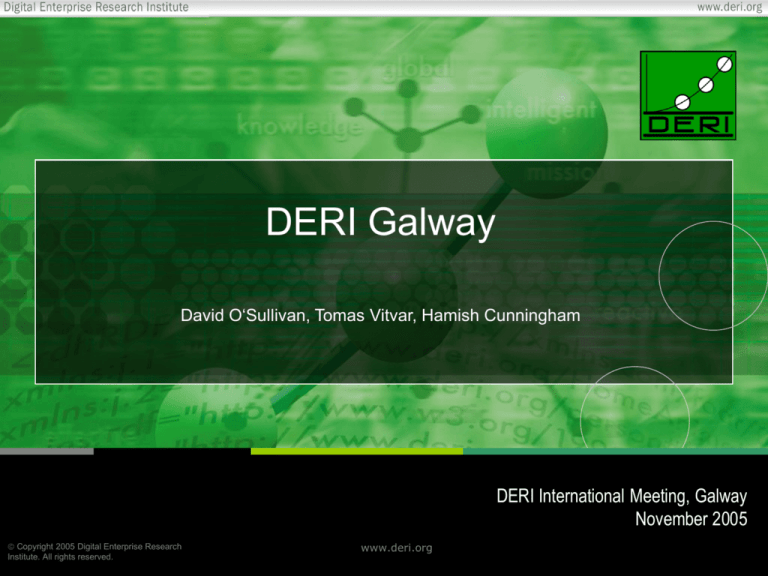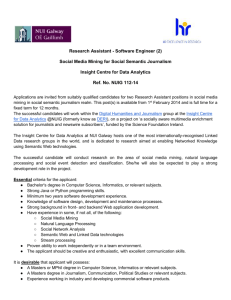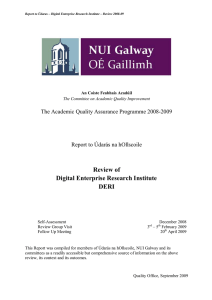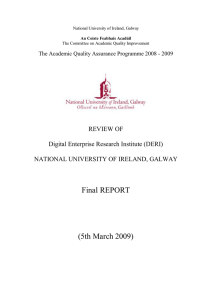
DERI Galway
David O‘Sullivan, Tomas Vitvar, Hamish Cunningham
DERI International Meeting, Galway
November 2005
Copyright 2005 Digital Enterprise Research
Institute. All rights reserved.
www.deri.org
Vision
• DERI Galway’s vision is to develop new knowledge and
disruptive technologies for the Internet
– Semantic Web Services
– Semantic Web
– Human Language Technology
2
Semantic Web Services
Dynamic
Static
3
UDDI, WSDL, SOAP
Semantic Web
Services
WWW
Semantic Web
URI, HTML, HTTP
RDF, RDF(S), OWL
Web Services
Semantic Web
4
Social
Connectivity
Blogs, OSNs, Wikis
Social
Semantic
Web
WWW
Semantic Web
URI, HTML, HTTP
RDF, RDF(S), OWL
Human Language Technology
Phase 1
Phase 2
Desktop/
Wiki
Phase 3
Semantic Desktop
HLT
Semantic P2P
Social
Semantic Desktop
Ontology driven
distributed
Social Networking
P2P networks
Semantic Web
Ontology driven Social Networking
Social Networking
5
Research Approach
• Knowledge
– Push leading edge approaches
– Publish new Knowledge
• Standards
– Semantic Web Services
– Social Semantic Collaboration
• Industry Collaboration
– Applications
– Testing and Validation
• Open source
– WSMX
– JeromeDL
6
Seed Funding
EU Funding (€7.5 M)
• DIP (2 M)
• ASG (0.5 M)
• KW (0.5 M)
• SWWS (200 K)
• AMI-4-SME (330 K)
• EastWeb (200 K)
• Nepomuk (1.25 M)
• SUPER (1.1 M)
• Tripcom (0.6 M)
• SemanticGov (332 K)
• SWING (314 K)
• RIDE (138 K)
• Ecospace (700 K)
Industrial Partners
(€4.2 M)
• HPGL (4M)
• HC-exchange (10K)
• SAP (220K)
SFI (9.9 M €)
• Lion (9.6 M)
• Supplemental Equipment (150 K)
• M3PE (174K)
• STARs (25 K)
• SeDiTo (open)
7
EI Funding (€2.4 M)
• Terra Nua (9 K)
• Storm (9 K)
• SOAR (340 K)
• SWORCA (40 K)
• eLearning (2 M)
IRCHSS (€0.1 M)
• Wiki Ireland (125 K)
italics: submitted
Summary
• Generate new knowledge and disruptive technologies for
the Internet
• Focus
– Semantic Web
– Semantic Web Services
– Human Language Technology
• Key Challenges
– Senior Appointments
– Management Structure
– DERI Intl Collaboration
8
Semantic Web
Copyright 2005 Digital Enterprise Research
Institute. All rights reserved.
www.deri.org
Current Research
• Semantic Web Search Engine (SWSE)
– Semantic Ontology Repository (YARS)
– Semantic Digital Library (JeromeDL)
• Social Semantic Collaborative Filtering (FOAFRealm)
• Semantic Bibliographic Descriptions (MarcOnt)
– Semantically-Interlinked Online Communities (SIOC)
• Social Semantic Desktop
– Semantic Blogs (semiBlog)
– Semantic Wikis (SemperWiki)
• Semantic Innovation
– Semantic Innovation Management System (SIMS)
– Ambient Intelligence for Manufacturing (AmI)
10
Business Development
11
Future Research
• AnnoWiki
– Create personal information management workbench by
integrating existing work lines
•
•
•
•
•
•
12
Social Semantic Desktop (NEPOMUK)
Semantic Digital Library
Semantic Interlinking of Online Community Sites
Ambient Intelligence for Manufacturing
eLearning
Skills Matching of Human Resources
DERI International Collaboration
• DERI Innsbruck
• DERI Korea
• DERI Stanford
13
Summary
• AnnoWiki, Nepomuk and eLearning are major research
thrusts
• Other minor thrusts e.g. AmI, Sioc, etc.
• DERI Intl Collaboration
• Key Challenges
– Recruitment of post-docs and PhD researchers
14
Semantic Web Services
Tomas Vitvar, Laurentiu Vassiliu, Michal Zaremba
<firstname.lastname>@deri.org
Copyright 2005 Digital Enterprise Research
Institute. All rights reserved.
DERI International Meeting, Galway,
November 2005
www.deri.org
Current Research
• Semantic Web Services
– WSMO, WSML, WSMX
– Ontologizing of EDI
– Multi-meta model process execution (m3pe)
• WSMX: Execution Environment for the SWS
–
–
–
–
16
Architecture: component-based, service oriented
WSMX Execution Framework
Data mediation, Process Mediation
Management Tools (WSMT): Ontology Editor, Data Mapping Tool
Business Development
• Bell Labs (telecommunications, e-business)
– Integration of voice, data and video services in the context of 3G
networks
– Dynamic supply chain
• Nortel Networks (telecommunications)
– Semantics in the call centre
• Capgemini (e-government)
– SemanticGov project
– Semantic Interoperability for PEGS
• STORM (e-business)
– E-procurement
17
Future Research
• WSMX WG to be moved to DERI Innsbruck
• SWS Focus for the future: Applied SWS
– apply, verify and align specifications around WSMO, WSML and
WSMX according to the real world use case scenarios
– Contribution to WSMO, WSML and WSMX WG
– Strong Collaboration with DERI Innsbruck
• Application Areas
–
–
–
–
–
–
18
E-Health
E-Government
Telecommunications
Business Process Management
GeoSpatial Services
E-Business
Research Projects
• E-Health:
– SAOR (EI): Interoperability of medical information systems,
– RIDE (EU FP6): Road map for semantic interoperability in eHealth
• E-Government:
– SemanticGov (EU FP6): Infrastructure for Pan-European EGovernment Services based on SWS technology
• BPM:
– SUPER (EU FP6): Semantic Utilised Process Management
within and between Enterprises
• GeoSpatial Services:
– SWING (EU FP6): annotation, discovery, composition, and
invocation of geospatial web services
19
DERI International Collaboration
• DERI Innsbruck
– WSMO, WSML, WSMX WG
• DERI Korea
– E-Health
• workshop on e-health in summer 2006 to exchange ideas between
projects on e-Health
– Telecommunications
• funding opportunities for joint project in semantic integration of
services in the context of IMS networks
20
Summary
• Past: SWS cluster: WSMX WG
• Future: Applied SWS
– Application domains: e-health, e-government, telecom, ebusiness, …
– Industrial Partners: Bell, Nortel, Capgemini, Storm
• DERI Intl Collaboration with Innsbruck and Korea
• Key Challenges
– Recruitment of Professor, post-docs and PhD researchers
21
Human Language Technology
Hamish Cunningham
<firstname.lastname>@deri.org
Copyright 2005 Digital Enterprise Research
Institute. All rights reserved.
DERI International Meeting, Galway,
November 2005
www.deri.org
Human Language Technology in DELTA
• The opportunity
• The problem
• Some solutions
digital
enterprise
language
technology
applications
23
The Opportunity: a Knowledge Economy
• Gartner, December 2002:
– taxonomic and hierarchical knowledge mapping and indexing will be
prevalent in almost all information-rich applications
– through 2012 more than 95% of human-to-computer information input
will involve textual language
• IBM 2004: 80% of corporate data is unstructured
• A contradiction: formal knowledge in semantics-based systems vs.
ambiguous informal natural language
• The opportunity: to reconcile these two opposing tendencies
24
The Problem: Deploying HLT Applications
25
domain
specific
simple
bag-of-words
acceptable
accuracy
complexity
entities
complex
relations events
Performance Level
Domain
specificity
vs. task
complexity
specificity
• Simple tasks: document clustering, full-text search, entities, simple
descriptions
• Complex tasks: relations and events, cross-document reference
• Specific domains: chemical engineering job descriptions, football match
reports
general
• General domains:
100%
all .ie news sites
90%
80%
30%
Some solutions
• AI’s image problem: when it succeeds, it’s not AI
• Successfull businesses exist selling MT, KBS, ANNs, but
they’re typically assistive
• DELTA will look at 4 semi-automatic applications
• Futures (1): Web-scale HLT and SWAN
• Futures (2): literate modelling
• Futures (3): redundant-source IE
• Futures (4): contextual identity
26









